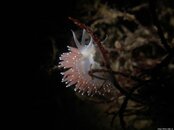I have to agree that you don't need a strobe, especially for macro photography. My favourite pictures of crayfish are all taken with only a can light.
However, it only works well for macro subjects, due to the small amount of area that must be lit. A lot of people are surprised at how little light is captured by their camera from their very bright light. Disregarding the fact that wattage doesnt exactly convey the lumens or lux output, due to different efficiencies at turning electricity into light, there is a huge difference between even a 21 watt HID and most strobes. The Ikelite DS125, a powerhorse for budget minded photographers around the world, is a 110 "watt second" strobe. Assuming you are shooting at a shutter speed of 1/125, a speed at which any strobe should be able to sync, you multiply 1/125 times 21 watts to get the watt-seconds of the cave light. Dont reach for a calculator, the answer is .168 (point one six eight, well under a single watt second). The DS 125 is so many times more powerful than the 21 watt HID, its no surprise that your pictures are turning out dark! But, this calculation only measures the overall amount of light (really, the energy used to make light, but we'll still ignore that), and it measures it at a maximum level. It doesn't tell you much about the exposure.
Shooting macro with a DS125, many people shoot at very high apertures. I tend to use f22 and up. This is to give me the max depth of field, and because I have plenty of light coming out of the strobe, I can afford to block some of it from entering the sensor. I could also turn the strobe down, and also lower the f stop, conserving battery power. If I turn it down enough, I'll get to some point where the amount of light is comparable to a can light.
Shooting with a can light means you'll need a rig you can shoot with 1 hand, but if you don't have strobes, most rigs can be handled with 1 hand. It means you'll probably want auto focus, unless you don't mind moving your hand back and forth between a good lighting position, and moving the focus knob. But, you have the benefit of instantly movable light source, which strobes don't have. With a strobe you might be loosening a knob, moving the strobe, then moving the other strobe, it gets old. Also, many lights are smaller than strobe heads, meaning you can stick them into some interesting holes and spots to get an interesting angle of lighting.
In short, while I have fun shooting macro with just a bright light, I also enjoy shooting with strobes. The most important thing is to always have fun!






